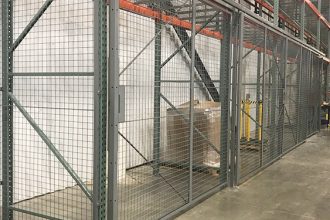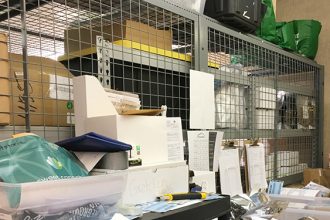Learn How Protective Guarding Has Evolved To Strengthen Worker Safety

This article previously appeared in MHI Solutions Magazine, Volume 10, Issue 4.
People need to feel safe to be productive, and in industrial environments a crucial component of keeping workers safe is keeping them adequately separated from certain equipment. Fixed protective guarding products, such as safety fences, netting, guardrails and bollards, are the key tools used to ensure manufacturing and distribution facilities are as safe as possible by keeping workers and potentially dangerous equipment away from each other.
Members of the Protective Guarding Manufacturers Association (ProGMA), an industry group within MHI, represent the industry’s leading suppliers of fixed protective guarding products designed to protect personnel, equipment, and inventory in industrial facilities. Occasional accidents are likely, but the ProGMA and its members strive to limit the dangers and damages those risks represent.
At its essence, protective guarding is about designing a flow and a guarding system that keeps people separated from equipment and machinery that could hurt them, said Dirk Seis, director of marketing for ProGMA member Ideal Warehouse Innovations, Inc. However, he said, sensitive, sophisticated equipment also needs guarding.
“In a typical facility, there is expensive machinery and if it is hit by moving equipment, it’s out of service. Some equipment can be worth millions of dollars, so protecting it from incidental impact is very important,” Seis said. “If you think of a warehouse like a roadway, there can be accidents every day. Guarding protects against all of that.”
In that vein, a major development in recent years in the protective guarding field is the emergence of guarding that can absorb multiple impacts without needing to be immediately replaced. In the “old days,” Seis said, steel guarding, which comprises fabricated steel components, was the only type of protective guarding available.
“These days, there are polymer designs, there are flexible designs, there are impactable designs, there are rebounding designs, and they allow multiple impacts in the same spot before repair is necessary,” Seis said. “You’ve got places where impact is more likely in a facility, and in those cases, many companies have chosen to put something in there that’s more forgiving while still protecting the product. It protects what it’s designed to protect, but it bounces back and lives another day versus traditional guarding, which is less costly, but it will typically only take one hit and then needs either significant repair or replacement.”
Seis said the European markets have more ambitiously made the transition to newer guarding that can absorb multiple impacts. The newer guarding is more expensive, he said, but can save money in the long term because of its ability to endure longer than traditional guarding.
“The more companies understand how much longer this newer guarding lasts and perform the ROI calculations, then the more this newer technology will be adopted,” he said.
Seis said protective guarding can seem deceptively simple. If there is a guarding system inside a facility, it often means people stay on one side of the guard and the moving equipment runs on the other side. Ensuring training emphasizes the importance of following the rules of the system are crucial, he said, and so is establishing prominent signage that makes it clear to everyone where they should be—and not be.
ProGMA recommends that facility and equipment owners perform a risk assessment to determine the guarding material most appropriate for any potential dangers in a building. In a blog post on the topic, ProGMA said the assessment should include a team of workers whose job responsibilities will lead them to interact with the equipment.
“This multi-step process involves identifying the hazards associated with the system or process, determining who might be at risk of harm from the machinery or equipment, evaluating the potential dangers, deciding how to best prevent them, and implementing the appropriate guarding type that will best mitigate those hazards,” according to ProGMA.
Putting together an effective guarding system in a facility, particularly a large facility, can be a highly complex process, Seis said. Ideal Warehouse Innovations, which provides rigid and rebounding guarding systems, has developed software called GRID (Guardrail Interactive Designer) to help customers design their guardrail system, matching the layout and equipment to their unique needs.
Good safety practices and equipment go hand in hand with high productivity, Seis said. That means developing a safety plan that employees can easily follow, helping to prevent incidents, keep people safe, limit damage to equipment and avoid costly work stoppages.
If a safety procedure is well-designed and straightforward for team members, it’s more likely to be used and to become part of the process, Seis said. “Wherever one can make the safety procedure easier, both in how to do it and how to understand how to do it, then it’s more likely to be executed and more likely to be effective.”



